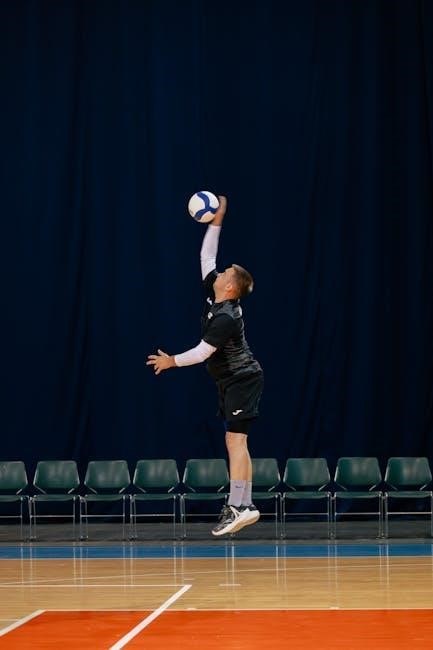Super Slow Strength Training involves performing exercises with very slow movement speeds, typically 10 seconds concentric and 6 seconds eccentric, promoting increased strength and muscle growth efficiently.
Definition and Overview
Super Slow Strength Training is a unique resistance training method characterized by extremely controlled, slow movements during exercises. It involves prolonging the time under tension for muscles, typically with 10 seconds for the concentric phase (lifting) and 6 seconds for the eccentric phase (lowering). This approach minimizes momentum and focuses on precise, deliberate movements, aiming to maximize muscle engagement and efficiency. Unlike traditional weight training, Super Slow Training often uses lighter weights but emphasizes intensity through prolonged duration. It is designed to enhance strength, muscle growth, and joint health while reducing the risk of injury. The method is versatile, suitable for individuals at various fitness levels, and can be applied to both free weights and machine-based exercises. By focusing on controlled movements, Super Slow Training promotes a safer and more effective way to build strength and improve overall muscular endurance.
History and Development
Super Slow Strength Training emerged as a distinct approach in the fitness industry, gaining popularity through the work of experts like Jeff Nelson, M.Ed., and Len Kravitz, Ph.D. This method emphasizes prolonged movement durations, typically 10 seconds for the concentric phase and 6 seconds for the eccentric phase, aiming to maximize muscle engagement. The rise of internet references and certifications has contributed to its growing recognition. Studies, such as those showing a 50% greater strength increase in Super Slow groups compared to regular-speed training, have supported its effectiveness. Over time, Super Slow Training has evolved, incorporating various exercises and equipment, and is now widely accepted as a safe and efficient way to build strength and enhance muscular endurance.

Key Principles and Concepts
Super Slow Strength Training is founded on the principle of performing exercises at a very slow pace, typically 10 seconds for the concentric phase and 6 seconds for the eccentric phase. This prolonged movement duration maximizes muscle engagement and minimizes the use of momentum, ensuring precise control and focus. The method emphasizes progressive overload, where resistance is gradually increased to continue challenging the muscles. By targeting both fast-twitch and slow-twitch muscle fibers, Super Slow Training enhances strength, endurance, and metabolic capacity. The approach also prioritizes compound movements, such as squats and presses, which work multiple muscle groups simultaneously. This efficiency allows for effective full-body workouts with minimal equipment, making it accessible and time-efficient while promoting significant muscle growth and strength gains.

Benefits of Super Slow Strength Training
Super Slow Strength Training enhances muscle growth, improves joint health, and boosts efficiency. It increases strength, supports injury prevention, and offers time-saving workouts with significant results.

Increased Muscle Growth and Strength
Super Slow Strength Training is highly effective for building muscle and enhancing strength. By focusing on slow, controlled movements, it maximizes time under tension for muscles, stimulating significant growth. This method emphasizes progressive overload, gradually increasing intensity to challenge muscles further. Studies show that Super Slow protocols, such as 10-second concentric and 6-second eccentric phases, can lead to remarkable strength gains compared to traditional lifting speeds. The prolonged muscle engagement ensures deep fatigue, prompting adaptive responses that promote hypertrophy. Additionally, the efficiency of Super Slow Training allows for impressive results with minimal training time, making it ideal for those seeking optimal muscle development without excessive time commitments. Its focus on intensity and precision ensures that every repetition contributes meaningfully to muscle growth and strength improvements, supported by scientific research and practical applications.
Improved Joint Health and Injury Prevention
Super Slow Strength Training is renowned for its ability to enhance joint health and reduce injury risks. By eliminating rapid, high-impact movements, this method minimizes stress on joints, making it ideal for individuals with mobility issues or chronic pain. The controlled, slow tempo of exercises ensures proper form and reduces the likelihood of overuse injuries. Additionally, the focus on muscle engagement rather than momentum promotes balanced strength development, which further protects joints. Studies have shown that Super Slow Training can improve joint stability and reduce inflammation, creating a safer environment for long-term strength gains. This approach is particularly beneficial for older adults or those recovering from injuries, as it prioritizes joint health without compromising the effectiveness of the workout. Its low-impact nature makes it a sustainable option for maintaining strong, healthy joints over time.
Enhanced Efficiency and Time Savings
Super Slow Strength Training offers a time-efficient approach to building strength and muscle. By focusing on slow, controlled movements, individuals can achieve significant results in shorter workout sessions. Typically, a full-body routine can be completed in just 20 minutes, making it ideal for those with busy schedules. The method emphasizes quality over quantity, ensuring each exercise is performed with optimal focus and intensity. This approach eliminates the need for lengthy workouts, as the slow tempo maximizes muscle engagement and metabolic response. Additionally, the structured format of Super Slow Training reduces the time spent transitioning between exercises, further enhancing efficiency. This makes it a practical choice for individuals seeking to improve strength and fitness without dedicating excessive time to their training routine. The condensed yet effective nature of Super Slow Training ensures a productive workout in minimal time.

How to Perform Super Slow Exercises
Super Slow exercises involve slow, controlled movements, typically 10 seconds concentric and 6 seconds eccentric, performed with full engagement and minimal rest between sets for optimal effectiveness.
Proper Form and Technique
Proper form and technique are critical in Super Slow Strength Training to ensure safety, effectiveness, and maximum muscle engagement. Each exercise should be performed with controlled, precise movements, avoiding any jerky or bouncy actions. The slow tempo, typically 10 seconds for the concentric phase and 6 seconds for the eccentric phase, requires focused attention to maintain proper form throughout the entire range of motion. Engage the target muscles intentionally, avoiding reliance on momentum or secondary muscles. Full muscle contraction and elongation are essential to stimulate growth and strength gains. Proper breathing is also vital; exhale during the effort phase and inhale during the return phase. Maintaining proper form ensures that the intended muscle groups are effectively targeted, reducing the risk of injury and optimizing results. A certified instructor can help refine technique, especially for beginners, to maximize the benefits of Super Slow Training.
Recommended exercises and equipment
Recommended Exercises and Equipment
Super Slow Strength Training emphasizes compound exercises that work multiple muscle groups simultaneously, enhancing efficiency and effectiveness. Recommended exercises include squats, deadlifts, bench presses, rows, and overhead presses, which target major muscle groups. These exercises can be performed using free weights, such as barbells or dumbbells, or with machines designed for controlled movements. Resistance bands are also a versatile and portable option for those who prefer minimal equipment. The focus is on basic, functional movements that promote overall strength and muscle development. For equipment, high-quality tools that allow smooth, consistent resistance are ideal. Whether using free weights or machines, the key is to prioritize proper form and controlled tempos to maximize results and safety. This approach ensures a well-rounded and effective workout regimen.
Breathing and Focus During Workouts
Proper breathing and mental focus are critical components of Super Slow Strength Training. The slow tempo requires controlled breathing to maintain form and maximize muscle engagement. It’s essential to avoid holding your breath, as this can lead to unnecessary tension and discomfort. Instead, exhale during the concentric phase (lifting) and inhale during the eccentric phase (lowering) to maintain a steady rhythm and prevent fatigue. Focus is equally important; concentrate on the muscle being worked to ensure proper activation and minimize the risk of injury. The slow, deliberate movements demand attention and intention, making mindfulness a key aspect of this training method. By combining controlled breathing with focused attention, you can optimize the effectiveness of each exercise and achieve greater results in less time.

Workout Routines and Schedules
Super Slow Strength Training typically involves 2-3 short sessions per week, with each workout lasting 20-30 minutes. Full-body routines focus on compound exercises for efficiency and time savings.
Sample Full-Body Routine
A sample Super Slow Strength Training full-body routine includes 6 exercises targeting major muscle groups, completed in 20 minutes. Start with a 5-minute warm-up, followed by 5 minutes of stretching. The routine includes leg presses, chest presses, rows, shoulder presses, lat pulldowns, and core exercises. Each exercise is performed with slow, controlled movements, typically 10 seconds concentric and 6 seconds eccentric. This approach ensures maximum muscle engagement and efficiency. The routine is designed to be time-effective, focusing on compound movements that work multiple muscle groups simultaneously. By minimizing rest periods and emphasizing proper form, individuals can achieve significant strength gains and muscle development in a concise workout session. This structured approach makes Super Slow Training ideal for those seeking efficient and effective full-body conditioning.

Split Routines for Targeted Muscle Groups
Split routines in Super Slow Strength Training allow for targeted focus on specific muscle groups, enhancing intensity and recovery. A common approach is to divide workouts into upper and lower body days. For example, dedicate one session to exercises like chest presses, rows, and shoulder presses, while another focuses on leg presses, curls, and core work. This method enables greater volume and attention to detail for each muscle group. By concentrating on fewer exercises per session, individuals can maximize time under tension and progressive overload. Split routines are particularly beneficial for intermediate trainees seeking advanced muscle development. They also offer flexibility, as workouts can be tailored to individual goals and schedules. Incorporating Super Slow principles ensures each exercise is performed with optimal form and intensity, leading to efficient and targeted strength gains. This structured approach helps avoid overtraining while promoting balanced development.
Frequency and Duration Recommendations
Super Slow Strength Training typically recommends 2–3 sessions per week, with each workout lasting 20–30 minutes. This frequency allows for adequate recovery time, essential for muscle growth and strength gains. Full-body routines are often performed twice weekly, while split routines may require more frequent sessions. Rest days are crucial, as they enable the body to adapt and rebuild muscle tissue. Beginners can start with two 30-minute sessions per week, gradually increasing frequency as they become more accustomed to the intensity. Each exercise is performed with slow, controlled movements, ensuring maximum time under tension. Consistency is key, as the method relies on progressive overload to achieve results. Overtraining is avoided by maintaining a balanced schedule, allowing the body to recover fully between sessions. This approach ensures sustained progress and long-term success. Proper planning and adherence to recommended frequencies are vital for optimizing the benefits of Super Slow Strength Training.

Maximizing Results with Super Slow Training
Super Slow Training maximizes results through progressive overload, proper nutrition, and recovery, ensuring sustained muscle growth and strength gains while maintaining focus and mind-muscle connection during workouts.
Progressive Overload and Intensity

Progressive overload is a cornerstone of Super Slow Strength Training, ensuring continuous muscle adaptation and strength gains. By gradually increasing resistance or time under tension, individuals can challenge their muscles more effectively. This method involves reducing rest periods, increasing exercise duration, or incorporating advanced techniques like negative repetitions or partial reps. The slow tempo (e.g., 10 seconds concentric, 6 seconds eccentric) allows for greater intensity without requiring heavy weights, making it accessible yet potent. Proper form and controlled movements are emphasized to maximize muscle engagement and minimize injury risk. Over time, this approach fosters significant improvements in muscular strength and endurance, even with minimal equipment. The key is consistency and gradual progression, ensuring the body is consistently challenged to adapt and grow.
Nutrition and Recovery Strategies
Proper nutrition and recovery are vital for maximizing the benefits of Super Slow Strength Training. A balanced diet rich in protein, carbohydrates, and healthy fats supports muscle repair and growth. Adequate hydration is essential to maintain muscle function and recovery. Post-workout nutrition should include a mix of protein and carbohydrates to replenish energy stores and promote muscle synthesis. Additionally, sufficient sleep and rest are critical for recovery, as muscles repair and adapt during rest periods. Managing inflammation through anti-inflammatory foods and supplements can also enhance recovery. A well-planned nutrition strategy ensures the body has the necessary resources to adapt to the demands of Super Slow Training, optimizing strength gains and overall progress; Consistency in both training and nutrition is key to achieving long-term success in this method.
Mind-Muscle Connection and Focus
The mind-muscle connection is a critical component of Super Slow Strength Training, as it enhances the effectiveness of each exercise. By focusing on the contraction and relaxation of specific muscle groups, individuals can maximize muscle fiber activation, leading to greater strength gains. This heightened awareness ensures that the target muscles are engaged optimally, reducing the risk of injury and improving overall training efficiency. Maintaining focus throughout the slow, controlled movements requires mental discipline, which is equally important as physical execution. Proper breathing techniques and concentration on form further amplify the mind-muscle connection, allowing for a more productive and safe workout experience. Cultivating this mental focus not only improves the quality of each repetition but also accelerates progress in strength and muscle development over time.
Super Slow Strength Training offers a safe, effective, and time-efficient method to build strength and muscle, making it a valuable approach for long-term fitness and health.
Super Slow Strength Training emphasizes slow, controlled movements to maximize muscle engagement and efficiency. It involves performing exercises with a focus on time under tension, typically 10 seconds concentric and 6 seconds eccentric. This method promotes significant strength gains and muscle growth while reducing injury risk. Proper form and technique are paramount, ensuring workouts are both safe and effective. The approach is time-efficient, requiring only 2-3 sessions per week, making it ideal for those with busy schedules. By focusing on compound movements and progressive overload, Super Slow Training optimizes results while minimizing wear and tear on joints. Its adaptability to various equipment, including bodyweight and machines, makes it accessible for all fitness levels. Overall, it stands out as a sustainable and effective way to achieve long-term strength and health goals.
Encouragement and Next Steps
Embrace Super Slow Strength Training as a transformative approach to building strength and improving overall health. With its focus on slow, controlled movements, this method is both efficient and safe, making it ideal for individuals of all fitness levels. Start by incorporating basic compound exercises into your routine, such as squats or chest presses, using either bodyweight or light resistance. Aim for 2-3 sessions per week, gradually increasing intensity as you progress. Track your workouts to monitor improvements in strength and muscle growth. Stay consistent, and you’ll experience enhanced joint health and a stronger, leaner physique over time. Remember, patience and dedication are key to maximizing results. Take the next step today and begin your journey toward a healthier, stronger you with Super Slow Strength Training!

Final Tips for Success
To achieve optimal results with Super Slow Strength Training, prioritize proper form and controlled movements throughout each exercise. Focus on engaging the target muscles fully to maximize strength gains and prevent injury. Incorporate a consistent warm-up routine to prepare your muscles and joints for the workout, and finish with a cool-down to aid recovery. Maintain a balanced diet rich in protein and nutrients to support muscle growth and energy levels. Ensure adequate rest between sessions, as recovery is crucial for progress. Gradually increase resistance or intensity to continue challenging your muscles, but avoid sacrificing form for heavier weights. Stay mentally focused during workouts, concentrating on the muscle contractions and slow tempos. Finally, track your progress regularly to stay motivated and adjust your routine as needed. Consistency and patience are key to long-term success in Super Slow Strength Training.
